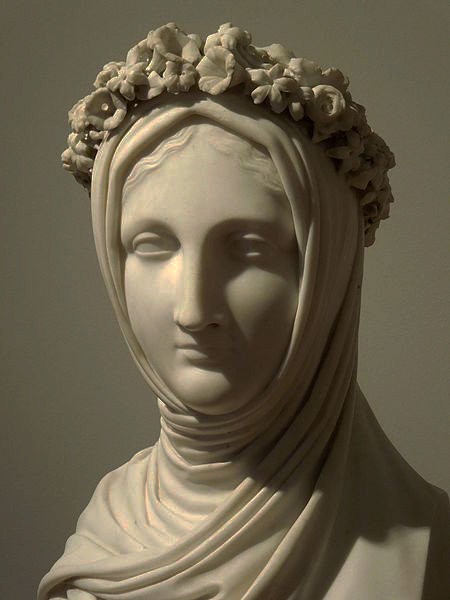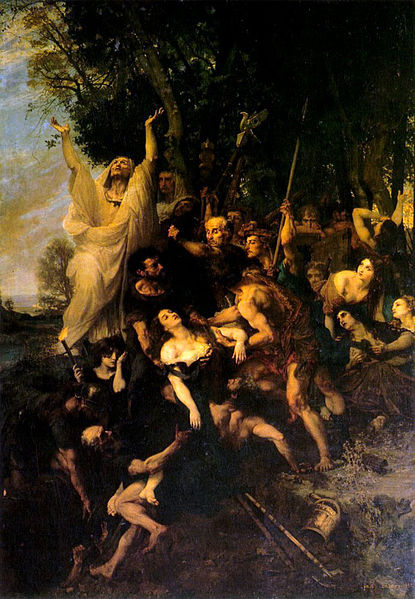
In the first century BC, Marcus Licinius Crassus, one of the richest and most powerful Roman citizen, nearly lost everything when he was accused of being too intimate with a Vestal virgin named Licinia. It was only when Crassus was brought to trial that his true motives emerged. It appeared that Licinia was the owner of a lovely villa in the suburbs which Crassus wished to have for himself at a low price. It was for this reason that Crassus was courting Licinia. This rather unfortunate reason saved both Crassus and Licinia as he was promptly acquitted when it became clear that Crassus’ wooing of the Vestal was motivated, not by lust, but by greed. Licinia herself might not have been too impressed hearing Crassus’ motive in wooing her. Nevertheless, this very motive saved her from the fate of being burried alive in the Campus Sceleratus (“Field of Transgression”), a Vestal’s punishment for for violating her oath of celibacy.

The poet Horace (65 – 8 BC) declared that Rome would stand “as long as the pontifex climbs the Capitoline beside the silent Virgin.” The “silent Virgin” was a Vestal virgin, a priestess of Vesta, the Roman goddess of the hearth and home. As the role of the Vestal virgin was that of an embodiment of the city and citizenry, the well-being of the College of the Vestals was regarded as fundamental to the well-being and security of Rome. Committed to the priestesshood before puberty and sworn to celibacy for a period of thirty years, the Vestals were also put in charge of keeping safe the wills and testaments of the most powerful people in Rome such as Julius Caesar and Mark Antony. When Sulla included the young Julius Caesar in his proscriptions, it was the vestals who interceded on Caesar’s behalf and gained him pardon.
They were the women of the city. Beloved and closely watched by the people as well as receiving invitations to the best and most important events in Rome, these ladies had premium seats at all the games, sitting close to the emperor and were granted great privilege and prestige. However, like other famous and much-watched women throughout history, the Vestals also had their brushes with scandals.

Historians Livy, Plutarch and Aulus Gellius attribute the creation of the Vestals as a state-supported priestesshood to king Numa Pompilius, who reigned circa 717–673 BC. Numa was very involved in the beginning of the college from the founding of the Temple of Vesta, appointing its first two priestesses and assigning them salaries from the public treasury, to appointing the Pontifex Maximus to watch over the Vestals. Numa was even said to have taken the first Vestal away from her parents himself in a ceremony called captio (capture).
The captio ceremony, the very first ceremony that a young Vestal would have experienced in her role, designated a Vestal as a spectacle. She became very much the property of Rome – all of Rome. The Vestals’ daily tasks, most of which were done openly at their temple at the very centre of the city such as the maintenance of the sacred fire of Vesta which was never allowed to go out, the collection of water from a sacred spring, preparation of food used in rituals and the care for sacred objects in the temple’s sanctuary, also confirm the Vestals functions as spectacles. Vestals accused and convicted of transgressing their status and role in Roman society through the allegation of violating their virginity were buried alive in an elaborate ritual – another spectacle for the Roman public.

It was both the Vestal’s virginity and emancipation from her family which enabled the Vestals’ to represent the collective Romans. A Vestal’s status as a virgin enabled her to devote her life completely to the priesthood, which in turn enabled her to represent the Roman collective and positioned her status as being fundamental to Roman cultural identity. A virgin by the ancient Roman understanding was an unmarried woman and the emancipation of a virgin, which the captio ceremony accomplished for each Vestal, ensured that each priestess was not legally associated with any particular family. This enabled the Vestal to represent the whole city as she was no longer tied to any particular family. A Vestal’s virginal sexual status enabled her to perform her daily religious tasks without polluting them and prevented the distractions generally brought about by husbands, lovers and an active sex life. As a Vestal’s virginity was thought to be directly correlated to the sacred burning of the fire, if the fire were extinguished it might be assumed that either the Vestal had committed a sin or that the vestal had simply neglected her duties.

British anthropologist Dame Mary Douglas provides a framework for understanding the relationship between the Vestals’ sexuality and the Roman society. She likened the society to the human body in which the orifices are to be carefully guarded to prevent unlawful intrusions. The idea of cherished bodily vulnerable to attack from the outside serves as a reason to pin blame to hidden enemies of society as well as a call to action which requires enemies to be unmasked and disabled. An example of this relationship between the society and the woman’s body is when Lucius Tarquinius Superbus, the last Etruscan king, raped Lucretia, the wife of a prominent noble in 509 BC. Lucretia committed suicide after publicly testifying to the crime due to her shame of having been violated. The Romans then appropriated the violated body of Lucretia to explain the existence of their state. Castitas (chastity) was just as important in Julius Caesar’s decision to divorce his wife Pompeia in 61 BC when, disguised as a woman, a young patrician named Publius Clodius Pulcher managed to gain admittance to the house to seduce Pompeia. Although Clodius was caught and prosecuted, he was later acquitted as Caesar gave no evidence against him at his trial. Instead, Caesar divorced Pompeia, saying that “my wife ought not even to be under suspicion”. The stories of Lucretia and Pompeia both demonstrate the extent to which women’s virtue and their bodies had enormous social potential. Roman society similarly appropriated the Vestals’ bodies and virginity and transformed the priestesshood into more than a religious institution, but rather, a microcosm of Rome.

Cases and punishments for a vestal’s unchastity were rare. In over one thousand years of the Order of the Vestals’ existence, there are only ten recorded convictions for unchastity. These trials all took place at times of political crisis for the Roman state which suggests that Vestal virgins were used as scapegoats in times of great crisis.
One of the most threatening catastrophes to Roman society during the period of the early and middle republic were Military disasters. The Romans believed that an interruption in the pax deorum (“peace of the gods”) often accounted for these threats. The Roman understanding of such crises were that if they were in trouble, the rites designed to protect them are not being performed as they should. Therefore, the way to restore safety is to sacrifice those who have betrayed them by not performing the rites properly. As most of the times it was impossible to directly determine the fault of the priestess, the accusations would be based on suspicions of the Vestal’s looks or daily habits. The Vestal Postumia, for example, was accused of crimen incesti (“crime of incest”) in 420 BC “due to the suspicion of her most attractive appearance and her habits were freer than was customary for a virgin.”

Prior to Rome’s victory in the Punic Wars, the Carthaginian general Hannibal annihilated several Roman armies in Italy during the Battle of the Trebia in 218 BC, the Battle of Lake Trasimene in 217 BC, and the Battle of Cannae in 216 BC. The annihilation of a third Roman army in three years at the Battle of Cannae opened the door to Italy for Hannibal and the Romans would spend the decade besieged in their own territory. Subsequently, the Vestals Opimia and Floronia were simultaneously accused and convicted of crimen incesti. If one Vestal’s transgression could threaten Rome, then surely two Vestals’ transgressions would have meant imminent and certain doom.
In 207 BC, while Hannibal was still menacing Italy, the Vestal Aemilia was also accused of incestum. However, Aemilia was not convicted of the crime as by 207 BC the situation had drastically improved and stabilized. Military disaster threatened the very existence of Rome and impious Vestals, as public spectacles maintaining the pax deorum, functioned both as an explanation for the catastrophe and, with their bodies, provided a means to restore the peace.

Other types of crises threatened the city and accusations of crimen incest against the Vestals include the Vestal Orbinia who was accused of crimen incesti in 472 BC in the year when a plague spread throughout the city which seems to have primarily affected the women, particularly those who were with child. Several centuries later, the Vestals Sextilia in 274 BC and Caparronia in 266 BC were accused of crimen incesti during the spread of another contagion affecting primarily pregnant women and children. This correlation between several incidents of crimen incesti and disease affecting women are not a coincidence as, if these plagues threatened the reproductive capability of the Roman family, then the disease was a threat to Roman society.
Jealousy, malice and suspicions also made the Vestal virgins vulnerable to false accusations. A famous tale from antiquity tells us that, when she was accused of unchastity, the Vestal virgin Tuccia snatched up her sieve and prayed to Vesta, “Vesta, if I have always applied chaste hands to your rites, make it happen that I may draw water from the Tiber with this and carry it into your house.” The goddess granted Tuccia’s prayer and the miracle was accepted as proof of Tuccia’s innocence. Had she been proven guilty, Tuccia would have been ritually buried alive. Tuccia has been extolled as an example of feminine virtue far beyond her Roman setting. In the modern era, Queen Elizabeth I commissioned a series of portraits that depict her holding Tuccia’s sieve, evoking the virgin’s power in matters of state.

